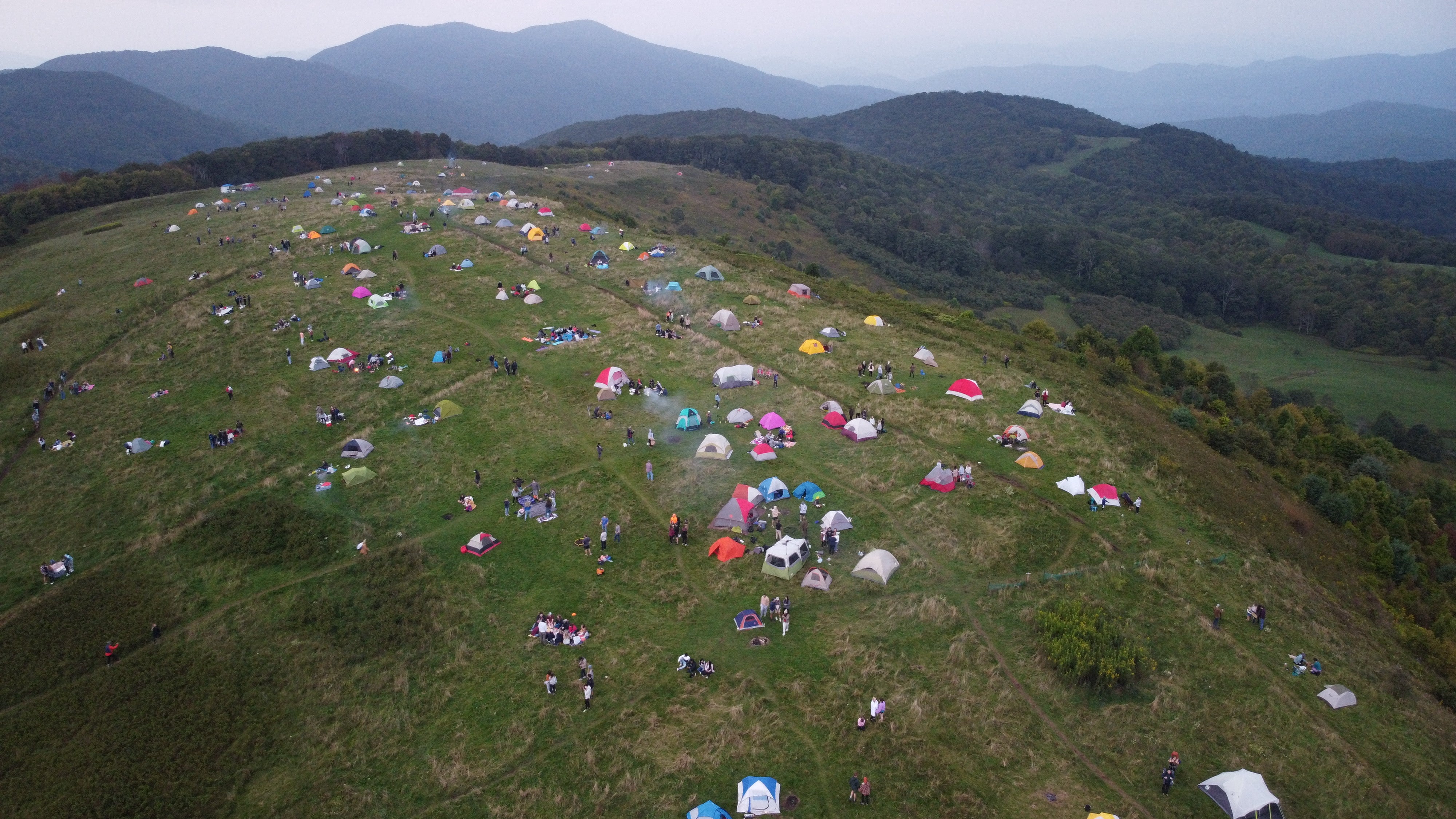A Crowd of Campers Trashed Max Patch

'Courtesy of Mike Wurman'
On September 18, 2020, Benny Braden and his friends made the half-mile trek up to North Carolina’s Max Patch’s lower shelf expecting a peaceful night in one of their favorite spots on the Appalachian Trail. When they crested the 4,600-foot, treeless summit, they realized they weren’t the only ones with that idea.
According to Braden, who is a hiking influencer under the name Plug-It In Hikes, Max Patch usually has no more than five campers at its peak at a time. But this weekend, he counted 30 to 40 tents.
Campers had left the bald littered with whiskey bottles, doggy bags, and other waste. An aerial photograph of Max Patch went viral this week, depicting the tremendous crowds on its peak.
“I just started bagging up trash,” he said. “By the time it was over with, altogether we collected five bags of trash, four pillows, three blankets, and one wagon with a busted wheel.”
Such scenes are becoming more common in wild places across the country. Under pandemic conditions, crowded outdoor spaces have become the new reality. According to Leave No Trace’s Education Director Ben Lawhon, in Colorado state parks alone, visitation has increased 33 percent due in part to COVID. According to a study Lawhon conducted for nine weeks between March and June with researchers at Pennsylvania State University, 40 percent of respondents envision that trend continuing after the pandemic winds down.
If new, typically inexperienced visitors are here to stay, Leave No Trace and local land managers are having to reckon with managing the additional impact and ensuring places don’t get loved to death.
Leave No Trace partners with the five largest federal land management agencies in the United States, as well as local and municipal entities in almost every state, to educate visitors about environmentally conscious practices. The organization has spread its message for more than 25 years, but as more and more inexperienced visitors venture into natural spaces, says Lawhon, director of education and research at Leave No Trace. “We’re having to think outside the box. A lot of the traditional mechanisms we’ve used to reach park and protected-area visitors just aren’t working.”
Lawhon and Leave No Trace haven’t done any in-person training or outreach this year, thanks to COVID. Instead, they’re using social media, in-park messaging, and virtual platforms to get their message across, but there are still plenty of examples of these educational attempts not connecting with visitors. Reports from the Naches Ranger District in Washington describe substantial increases in trash, human waste, and erosion in the Okanogan-Wenatchee National Forest since the beginning of the pandemic, even with Leave No Trace practices being accessible both online and in the parks themselves.
Steven Reinhold of The Appalachian Adventure Company, who resides near Max Patch, believes that another potential solution is to increase infrastructure and amenities in wild areas. According to Reinhold, natural spaces like Max Patch could benefit from more trash receptacles, restrooms, and parking space.
“I grew up an Edward Abbey fan, and I know he’s probably rolling over in his grave in the desert because I mentioned putting in a bathroom,” he joked. “But at this point, I don’t really see any other way.”
Reinhold is also the creator of #trashtag, a social media initiative encouraging users to snap photos of themselves picking up trash and post them on social media with the hashtag. According to Reinhold, #trashtag has seen more than 50 million uses across social media platforms.
Braden, the influencer who spent much of last weekend picking up trash on top of Max Patch, is also a vocal supporter of using social media to raise awareness of the ethical responsibility visitors have to parks and protected areas. He feels that influencers like him “should be doing more to show and educate Leave No Trace practices.”
Further, Lawhon emphasizes the importance of combining lots of different strategies to manage natural spaces.
“Restroom facilities? Great idea. Trash bins, recycle bins? Certainly can help,” he explained. “Is it going to fix every problem? Probably not. Could it help with a lot of them? Sure, but it’s got to be coupled with education.”
Reinhold and Braden hear that message loud and clear. On Friday, the two plan on hosting a cleanup at Max Patch, where Reinhold will roll out his upcoming initiative “Save Our Summits.” The initiative calls upon outdoor enthusiasts to hike to their favorite summits, create videos explaining how they can be saved, and post those videos to social media. The idea is to use the “Save Our Summits” platform to encourage tangible action in parks and protected areas, incorporating both indirect and direct forms of land management.
Reinhold hopes that “Save Our Summits,” much like #trashtag, will inspire hikers to take action on their own to clean up their local trails.
“Every area has their own Max Patch,” he says. “You know which places those are. Protect them before they’re loved to death.”
Despite the new challenges posed by increased visitation to wild spaces, Lawhon emphasizes that “When we can pull more people into the fold and get more supporters of parks and protected areas, that’s good for all of us who have a stake in the outdoors.”